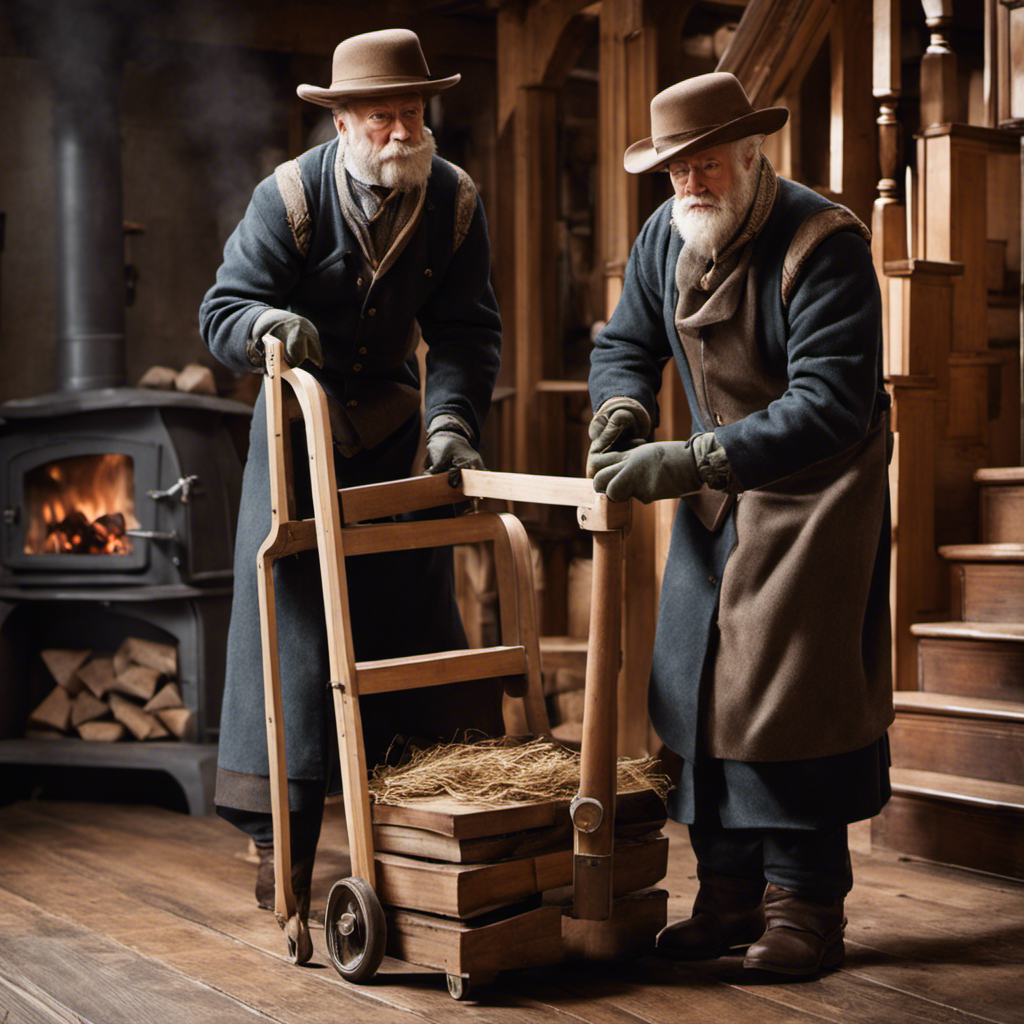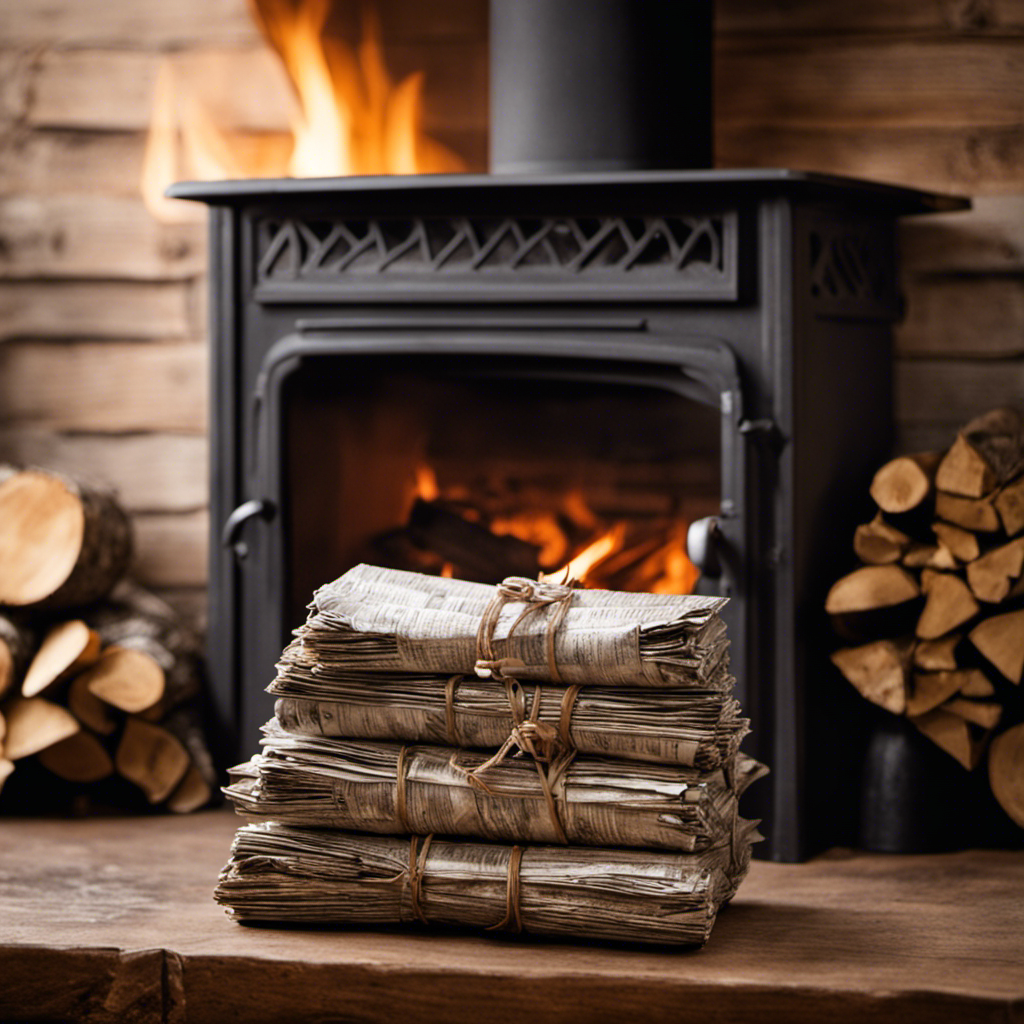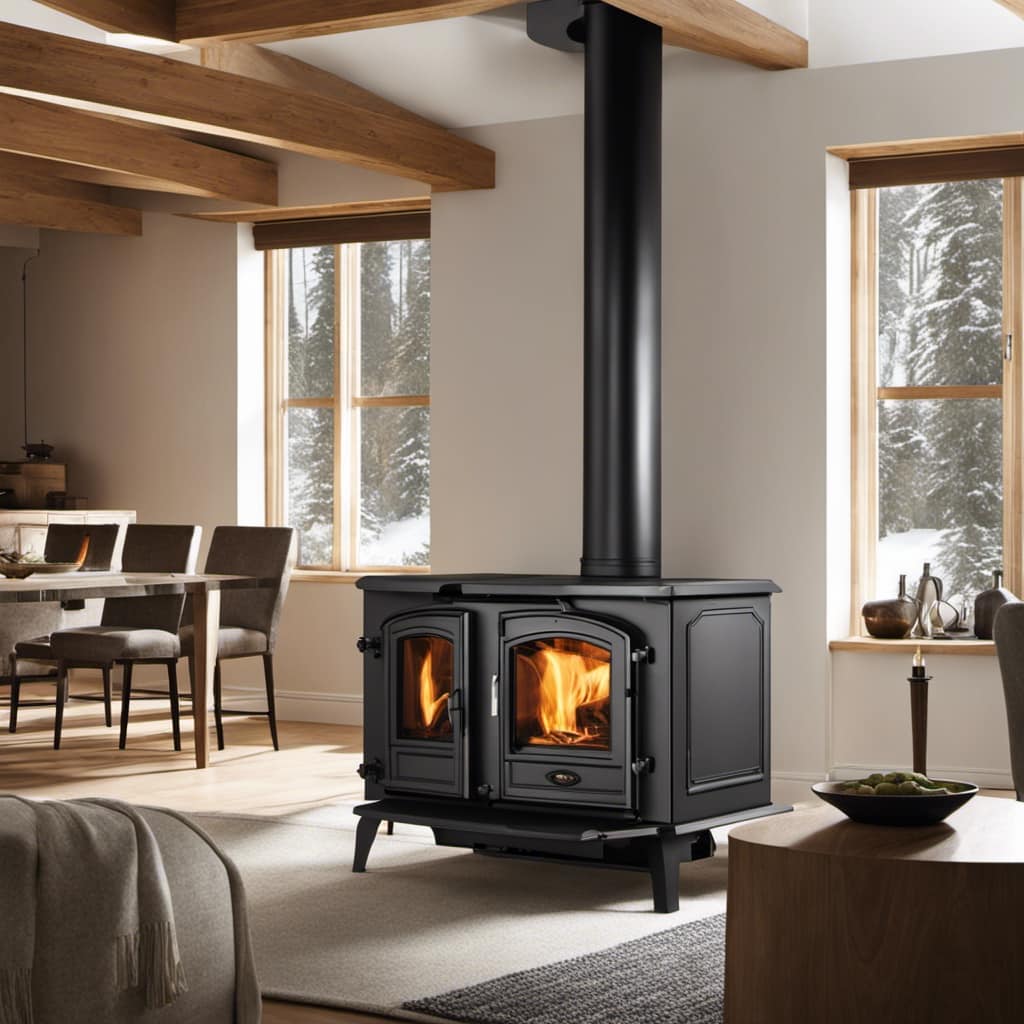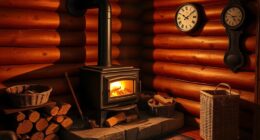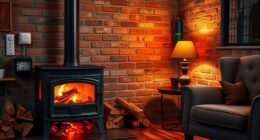Here’s a pro tip for you – relocating a wood stove is doable. With some knowledge and careful planning, you can effectively move your cherished wood stove to a new location safely.
In this article, I’ll share the steps and tips that will make this process a breeze. From assessing the weight and dimensions to securing and protecting the stove for transportation, I’ve got you covered.
So, let’s get started on this exciting adventure!
Key Takeaways
- Properly assess the weight and dimensions of the wood stove before attempting to move it.
- Use the appropriate tools and equipment, such as a dolly, pry bar, moving blankets, and straps, to safely move the wood stove.
- Take necessary precautions when disconnecting and removing the stove pipe, wearing protective gear and avoiding damage to the pipe.
- Secure and protect the wood stove for transportation by using packaging materials, securing the stove door, and ensuring it is tightly secured to the transportation vehicle.
Assessing the Weight and Dimensions of Your Wood Stove
I’ll measure the weight and dimensions of my wood stove to ensure I can safely move it. Determining the proper lifting technique and ensuring a clear path for moving the wood stove are crucial steps in successfully relocating it.
Before attempting to lift the stove, it’s essential to know its weight and dimensions. This will help determine the equipment needed and the number of people required for the job. To measure the weight, I’ll use a scale capable of handling the stove’s load. Carefully place the stove on the scale and record the reading.
Next, I’ll measure the dimensions of the stove, including height, width, and depth. These measurements will guide me in determining the amount of clearance needed to move the stove safely and efficiently. Once I’ve the weight and dimensions, I can assess the proper lifting technique and decide if additional equipment, such as dollies or straps, are necessary.
Lastly, ensuring a clear path for moving the wood stove is crucial. I’ll remove any obstacles or furniture that may obstruct the way, allowing for a smooth and safe relocation process.
Gathering the Necessary Tools and Equipment
To gather the necessary tools and equipment, I’ll need a dolly, a pry bar, and some moving blankets. These items are essential for a successful wood stove move and will make the process much easier and safer.
Here are three reasons why these tools are crucial:
-
A dolly: This sturdy piece of equipment will help me transport the heavy wood stove with ease. It has wheels that can handle the weight, reducing the risk of strain or injury during the move. With a dolly, I can easily maneuver the stove through narrow spaces or up and down stairs.
-
A pry bar: This tool will come in handy when removing any attachments or fasteners from the wood stove. It allows me to safely disconnect the stove from the surrounding area and prepare it for transportation. A pry bar ensures that no damage is done to the stove or its surroundings during the disconnection process.
-
Moving blankets: These thick, protective blankets will help prevent any scratches or dents to the wood stove during the move. By securely wrapping the stove with moving blankets, I can ensure that it remains in pristine condition throughout the journey to its new location.
Choosing a suitable location for your wood stove is crucial to avoid potential hazards and maximize its efficiency. Additionally, finding professional movers for assistance can greatly simplify the process and ensure a smooth transition. Once these preparations are complete, the next step is to disconnect and safely remove the stove pipe.
Disconnecting and Safely Removing the Stove Pipe
Disconnecting and safely removing the stove pipe requires careful handling and attention to detail. Before starting the process, it’s essential to ensure the stove is completely cooled down. Safety should always be the top priority when working with a stove pipe.
To begin, I recommend wearing protective gloves and goggles to prevent any accidents. Start by disconnecting the stove pipe from the stove itself. This can usually be done by loosening the clamps or screws that hold the pipe in place. Once disconnected, carefully remove the pipe section by section, taking care not to damage the surrounding walls or flooring.
While removing the stove pipe, it’s a good opportunity to clean and maintain it. Use a wire brush to remove any creosote buildup or debris. Creosote is a highly flammable substance that can accumulate in the pipe over time, so it’s important to clean it regularly to prevent chimney fires.
After cleaning, proper disposal of the stove pipe is crucial. Check with your local waste management regulations to determine the correct method of disposal. Some areas may require you to take it to a specific facility, while others may allow you to dispose of it with regular household waste.
Securing and Protecting the Wood Stove for Transportation
Securing and protecting the stove for transportation requires careful consideration of its weight and dimensions to ensure it’s properly secured and won’t shift during transit. When preparing a wood stove for transportation, there are several important steps to follow to ensure its safe arrival at the new location.
-
Packaging materials for wood stove transportation: It’s crucial to use appropriate packaging materials to protect the wood stove during transit. This may include bubble wrap, foam padding, or specialized stove covers. These materials help prevent scratches, dents, and other damage that could occur during transportation.
-
Securing the stove door during transportation: The stove door must be securely closed and locked to prevent it from swinging open during transit. This can be done by using straps or ropes to keep the door tightly shut. Additionally, placing a piece of foam or padding between the door and the stove body can provide extra protection and prevent any potential damage.
-
Properly securing the wood stove in the transportation vehicle: To prevent the stove from shifting during transit, it’s important to secure it tightly to the vehicle. This can be done by using straps or ropes to secure the stove to the vehicle’s anchor points. It’s crucial to ensure that the stove is stable and won’t move around during transportation.
By following these steps and using proper packaging materials, you can ensure that your wood stove is protected and secured for transportation.
Now, let’s move on to the next step: loading and unloading the wood stove safely and efficiently.
Loading and Unloading the Wood Stove Safely and Efficiently
Loading and unloading safely and efficiently requires careful planning to ensure the process is smooth and damage-free. When it comes to moving a wood stove, it’s crucial to employ the right loading techniques and proper lifting techniques.
To begin, make sure to clear a path from the stove’s current location to the transportation vehicle, removing any obstacles that could impede the process. It’s advisable to use a dolly or a hand truck to move the wood stove, as it will make the task easier and reduce the risk of injury. Before loading the stove onto the dolly, ensure that it’s properly secured, with any loose parts or accessories removed and stored separately.
When lifting the stove, remember to bend with your knees and use your legs, not your back, to bear the weight. Maintain a firm grip on the stove, and be cautious of any sharp edges or protruding parts.
During the unloading process, follow the same techniques in reverse, ensuring that the stove is safely placed in its new location. By utilizing these loading techniques and proper lifting techniques, you can ensure a safe and efficient wood stove relocation.
Frequently Asked Questions
Can I Move a Wood Stove by Myself or Do I Need Assistance?
Moving a wood stove alone can be a challenging task, especially considering its weight and size. It’s advisable to seek assistance or hire professionals for wood stove relocation. They’ve the necessary experience and tools to safely move the stove without causing any damage or injury.
It’s important to prioritize your safety and the protection of your property, so it’s best to leave this task to the experts.
Is It Necessary to Clean the Wood Stove Before Moving It?
It is important to clean the wood stove before moving it.
Cleaning the stove ensures that any built-up debris or ashes are removed, reducing the risk of a mess during transportation.
Additionally, cleaning the stove allows you to inspect and maintain its components, ensuring that everything is in proper working order.
How Do I Safely Transport the Wood Stove Without Causing Damage?
To properly secure a wood stove for transportation, you’ll need a few essential tools and equipment.
First, make sure to disconnect the stove from the chimney and remove any remaining ashes.
Then, use moving straps or heavy-duty rope to secure the stove to a dolly or sturdy cart.
Don’t forget to protect the stove with blankets or padding to prevent scratches.
With these precautions in place, you can safely transport your wood stove without causing any damage.
What Precautions Should I Take to Prevent Scratching or Damaging the Floors During the Move?
To prevent scratching or damaging the floors during a wood stove move, there are a few precautions I always take.
Firstly, I make sure to protect the floor by placing a heavy-duty drop cloth or cardboard underneath the stove. This helps to prevent any accidental scratches or dents.
Additionally, using furniture sliders or a sturdy dolly can make the moving process smoother and reduce the risk of floor damage. These tools provide a cushioned and stable base for the stove, making it easier to maneuver.
Are There Any Specific Regulations or Permits Required When Moving a Wood Stove to a New Location?
When it comes to regulations and permits for moving a wood stove, it’s important to be well-informed. Understanding any specific requirements can save you from potential headaches down the road.
Whether it’s obtaining permits from local authorities or adhering to safety regulations, staying on top of the necessary paperwork is crucial. By doing so, you can ensure a smooth and hassle-free relocation for your wood stove.
Conclusion
In conclusion, moving a wood stove requires careful planning and the right equipment. By assessing the weight and dimensions of the stove, gathering the necessary tools, disconnecting the stove pipe, and securing the stove for transportation, you can ensure a safe and efficient move.
Remember to load and unload the stove with caution to avoid any accidents. So, whether you’re relocating or simply rearranging your home, these steps will help you move your wood stove with ease.
Logan’s affair with adventure began in childhood. He hailed from a small town where vast forests bordered one side and endless shores stretched on the other. His days were spent exploring uncharted woods, climbing tall trees, or listening to the tales of old sailors. This early immersion in a world brimming with stories and mysteries became the foundation of his passion for writing.

